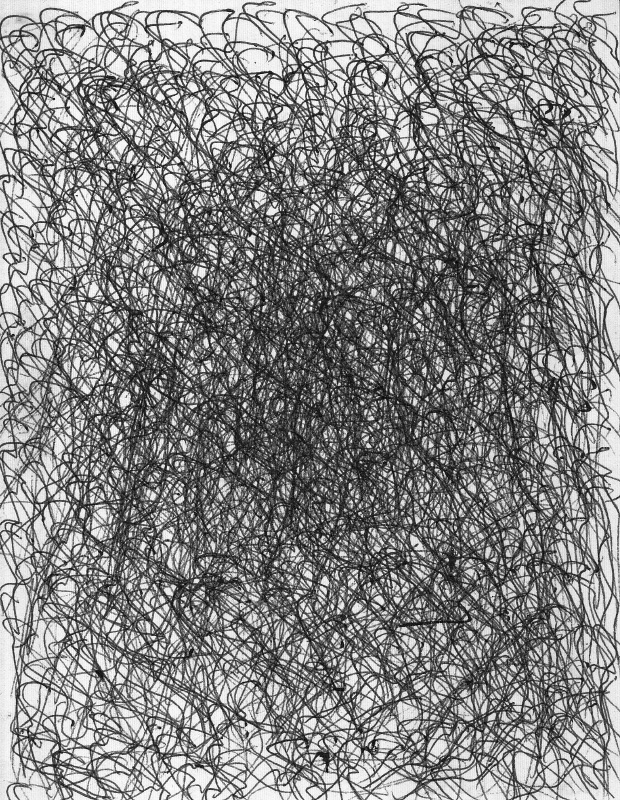Meditative Mandalas
A process-driven drawing project for high school students to experience flow and bring calm focus to drawing practice.
By Valerie Xanos
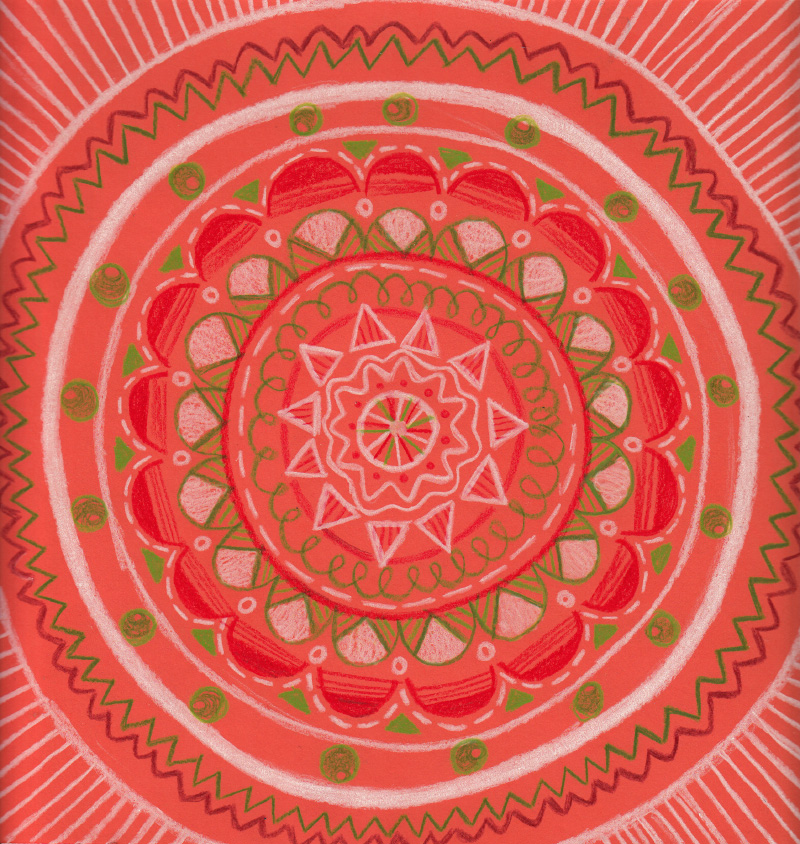
Today, we have so little down time. Our lives are filled with constant stimulation: music on iPods, phones, TV, texting, social media. We are bombarded by information and stimulus at all times. We lose chances for reflective and meditative states. We lose chances to be in a state of “Flow,” defined by Mihaly Csikszentmihalyi as “A state of heightened focus and complete immersion in activities such as art, play and work.” Flow can enhance focus and skills, and provide creative openness during artmaking.
This project aims to give students the chance to explore and experiment as contemporary artists, considering their senses and trying to understand how these “accidental” skills lead to great art making (as opposed to traditional studio skill building). Students will explore mark making in a variety of ways, utilizing technical skills, a variety of media, tactile performance methods, and experimentation. In addition to personal experimentation in their art, students will be encouraged to talk and write about their art in new ways.
This lesson was implemented in the second quarter. We spent the first quarter exploring drawing processes, exploring media possibilities and use (or unusual use) of media, drawing limitations, and how to unlock the imagination. This lesson came after all of that exploration in order to pull students forward into thoughtfulness and mindfulness. I'm hoping that after this they can step forward into an even more aware and thoughtful artistic process.
Through this project, we explored the following Essential Questions/Avenues of Inquiry:
- How do people access creativity and freedom while in a state of Flow?
- How can meditation or day-dreaming connect to Flow?
- How can we achieve a heightened sense of awareness of Flow?
- How can Flow be used to create artwork?
We were inspired first by the concepts of Flow, later by an artist named Scott Ramon (automatic drawings) and then by Tibetan Mandala art. This was very hard for students at first and I kept expecting a revolt. In the end their reflections were overwhelmingly positive and they LOVED the chance to experience this state of being while creating.
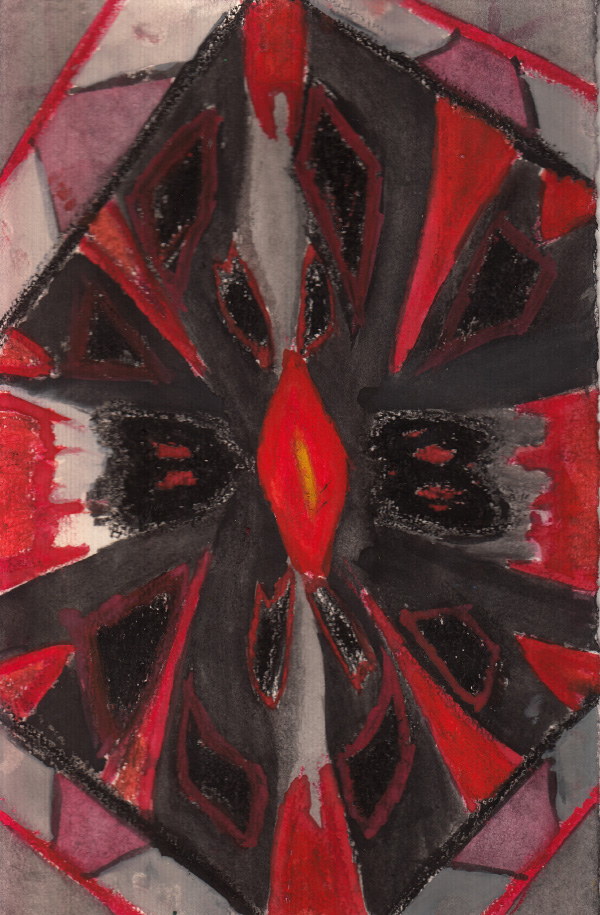
- To attempt to not only understand Flow, but to experience it during a creative process.
- To use the state of Flow to enhance the creative process and tap into an inner space that can make students stronger artists, more thoughtful and intuitive.
- To exercise a certain mental discipline needed for the meditative state of Flow.
Documentation + Assessment Suggestions
- Exit slips that are reflective, about students’ own experiences of Flow, what helps induce Flow, etc., after each discussion.
- Journaling using Studio Thinking language after each artwork.
- Gallery Walks that lead to small verbal group critiques.
Learning Activities
Day 1: Rhythmic Drawing
Materials: Playlist of 5 songs with different kinds of rhythm, speakers, 9 x 12 drawing paper, two pencils for each student, masking tape.
Setup: Have students tape paper onto table (small tabs of tape at each corner is sufficient).
Discussion: Students talk about how the movement of dance interprets rhythm.
Create rhythm and movement: Ask half of the class to drum out a rhythm onto the table with pencils. At the same time, ask the other half to move their body (or at least hands) according to the rhythm. (30 seconds)
Demo: Using BOTH hands, holding a pencil in each, draw on the paper according to the rhythm of a song. Encourage students to interpret different layers of rhythm (drumming, voice, instruments, etc).
- Students should concentrate on their movements, not the drawing. Ask them to think of it as “hand dancing” and the pencil merely records the movement. They should change their movement according to the type of rhythm (short, staccato, long, flowing, etc.). The marks made will change accordingly.
Play the first song. Choose songs that have different types of rhythm. (Ex: Drummers of Burundi, Bad Brains, M.I.A., etc)
Students begin “hand dancing” and drawing with both hands.
Walk around & Coach students as they draw—change movements according to rhythm changes.
- For example: Staccato rhythms—quick short movements and marks. Flowing rhythms—curvilinear marks. Skipping rhythms—varying marks in a pattern, etc.
- Listen to different layers of rhythms. How will marks change to record voice rhythm over drums?
5 Songs, Same Paper: Students continue to draw on the same paper for all 5 songs. Movements and marks should change as the rhythm changes.
The result is a fairly symmetrical, abstract drawing with varieties of mark-making.
Homework: Google Gallery (GG) Research
Experimenting with Line
Students will find 5 examples where artists are exploring the possibilities of line. They should break rules, push boundaries, and use line in a way OTHER than an observational, representation, realistic rendering of a subject. Instead, they should use line to express emotion, explore movement/texture, explore non-representational use of line, using 3D or 4D ways to create line, or some other way to experiment. For each artist in your gallery, write a sentence answering this prompt:
“What did the artist do with line that makes this experimental?”
Day 2: Movement Mapping
Students will move around the room while drawing, carrying sketchbooks.
Note: Place tables and create a sort of obstacle course to encourage them to weave around instead of circling the room.
Discovery Path: Students will track their OWN movement with different marks to record an interpretation of different kinds of movement.
- Students track their own movement using marks drawn on the paper in a weaving path.
- Hopping, jumping, crawling, sliding, rolling, walking, dancing, etc. Each type of movement should be expressed with a different type of mark the student chooses.
- Encourage more than just walking, can shout out different commands like Simon Says: “dance, now jump, hop, shuffle feet sideways,” etc.
Emotions: Students will track another student’s movement while trying to express different emotions with movement. What marks can be used to interpret that emotion?
- Form small groups of 4 or 5. One person is the MOVER, others are OBSERVERS.
- Observer students track the Mover student’s movement. Mover will move in accordance to a chosen emotion they decide in their mind, while the rest of the group observes and interprets that movement with marks. Mover should periodically change that emotion and movement. Observers continue to try to capture the physical expression.
Write a response to this prompt on back of the drawing: “Can you identify by the marks the type of emotion demonstrated in the movement? Yes? Describe what kinds of marks you used. No? Explain how you could change that.”
Day 3: Compulsive/Repetitive Marks
Materials: 4” x 5” paper (2 each), pencil, Philip Glass music (Satyagraha Act 1) or similar repetitive hypnotic music, graphite pencils.
Short Introductory Definition: “What is Flow?” (reference to Csikszentmihalyi definition) (15 minutes)
Show images of artwork done by Scott Ramon. He works in a meditative state using compulsive and repetitive mark making. (can substitute another artist)
Demo (see step 3 above, short 2- or 3-minute demonstration)
Students Draw: Choose ONE mark, consider direction, length, quality.
- Drawing 1: Draw the same mark over and over.
- Consider overlapping or placement within the space.
- Fill the area with repetitions of the mark for 5 minutes.
- Let the repetition allow you to “space out” and enter a state of Flow.
- Change the mark. Ask: “How does this interrupt or change flow?”
- Repetitively draw the new mark for 5 minutes.
- Change the mark a third time. After 2 minutes, allow the mark to change on its own as you repeat and work for 5 minutes.
- Goal: allow the mind to drift, let repetition become meditative.
- Drawing 2: (3 minutes) New sheet of paper: Choose a mark and while repeating it, focus on one thing: Placement. Where will you place each mark so that there is some negative space in the composition?
Reflection: Write a response to this prompt on back of drawing: “What thoughts were going on while you drew?”
Day 4: What is Flow?
How do we experience Flow? Context in Student’s Lives.
Teacher-Led Discussion of Flow:
According to Csíkszentmihályi “A state of heightened focus and complete immersion in activities such as art, play and work.” He describes the mental state of flow as “being completely involved in an activity for its own sake. The ego falls away. Time flies. Every action, movement, and thought follows inevitably from the previous one, like playing jazz. Your whole being is involved, and you're using your skills to the utmost."
Components of Flow
- Strong concentration and focused attention.
- The activity is intrinsically rewarding.
- Feelings of serenity; a loss of feelings of self-consciousness.
- Timelessness; a distorted sense of time; feeling so focused on the present that you lose track of time passing.
- Immediate feedback.
- Knowing that the task is doable; a balance between skill level and the challenge presented.
- Feelings of personal control over the situation and the outcome.
- Lack of awareness of physical needs.
- Complete focus on the activity itself.
Students break into small groups.
Students brainstorm 5 activities when they experienced a state of flow. Share this list with the class.
Note: Be careful to know the difference between “leisure activities” and “flow activities."
Teacher will create a Class Word Map on the whiteboard showing relationships between activities. Students will help decide these relationships and create further context for their own lives.
Brainstorm a list of environmental attributes that support or amplify a state of Flow.
For example: candles, quiet, music playing, repetitive movement, nature, bedroom, a clean space, etc
Exit Slip - Reflection: “Describe the qualities of a supportive environment that amplifies your State of Flow. For example: specifically what kind of lighting? What music? Where? Reflect upon WHY you think these supports help.”
Day 5 – Meditative Mark-Making
Materials: 4” x 6” Watercolor paper, watercolor paints, brushes, acrylic paint, colored pencils, markers. Set up before class begins.
FOCUS: How Do We Access Flow?
Students will construct a space where they can tap into Flow.
Take 5 minutes for students to reflect upon and share a past experience of Flow, and describe what in their environment amplified their focus? (yesterday's exit question)
For example: mellow sounds, certain tone of singing, soft music, rhythm of things going past window in car or bus, incense, candle-light.
Physical preparation: Have students stand and do some basic yoga stretches (sun salutation) and deep cleansing breaths.
Play music: Students could listen to their choice of meditative music on their ear buds. I had my choice of music playing: Philip Glass’s Satyagraha, Tolstoy Scene 1 (click to hear).
Create: Have a choice of 2D materials (paint markers, sharpies, oil pastels, watercolors, acrylic paint, colored pencils, graphite pencils, etc.) on the table in front of students.
- Ask students to create an artwork that uses focus and attempts to tap into a meditative flow.
- Tell them to think of it as creating the space to practice the kind of state that would be conducive to Flow.
- While listening to music, make varieties of marks while trying to allow Flow to guide them. (Focus on mark making: lose time, lose self, allow thoughts to flow through, not settling on one).
Prompts for the artwork:
Use repetitive marks
Consciously create negative space
No talking. Focus on music and mark-making. Allow the mind to be transported away from the world; practice loss of self.
Day 6 - Meditative Monday
Finish the meditative drawing to music that we started on Day 5. Repeat the steps of Day 6, minus the first discussion step.
Day 7 – Mandalas: Understanding the Art World
PowerPoint of Tibetan Mandalas and Thangka images, explanation of how they are used for meditation/focus/flow. (10 minutes)
Students do sun salutation stretches & deep breaths to physically prepare. (2 minutes)
Teacher coaches students through a Meditative Envisioning exercise (describing someplace serene, w/ water and wind for movement) (5 minutes)
Coach students in a quiet voice. Describe a meditative and serene scene where they can feel Flow. Ask them to envision it in their minds as you describe it.
**Students receive materials: colored square paper (7” x 7”) and colored pencils.
Drawing: Try to maintain a meditative mood in the room, with Satyagraha playing quietly in the background. Give students a common starting point for their drawing. Coach them through the beginning of the drawing.
Script: (Teacher will say)
- Choose a color that contrasts with your paper.
- Draw a small circle in the center of the paper
- Choose a spot on the circle, now make a mark.
- Repeat that mark around the circle
- Choose another spot on the circle, make a different kind of mark.
- Repeat the new mark, around the circle, but allow it to change. (direction, width, texture, length, etc)
- Choose another spot on the circle, draw a shape extending out toward the edges of the paper. Decide how far it needs to go. Should not touch the edge of paper.
- Repeat that shape around the circle.
- Create a shape that encloses your central circle. Can be any shape. Somewhere near it, you decide how near or far.
- Choose a spot in the negative space between the two shapes, but near the circle. Draw a mark or shape. Repeat that shape around the center, but allow it to slowly change and evolve.
- Choose a spot outside of one of the newest marks, use the side of your pencil lead to make a new mark that works inward toward the center and overlaps at least 2 other marks. Purpose is to change the texture.
- Repeat that mark around the center.
- Continue to add marks or shapes concentrically around the center. Allow the design to build outwards from the center. Can draw images as well as abstract shapes/marks. Must repeat.
- Focus on creating marks that, while repeating, explore various directions, sizes, and textures.
- Do not stop until class is over. Keep making marks, shapes, textures. Stay focused and quiet. Allow thoughts to flow through you, try to lose sense of physical self, time, and space.
Prompts for the artwork:
- Circular radiating pattern
- Variety of colors
- Use repetitive marks that alter and vary throughout class.
- Consciously create negative space
- No talking, focus on music and mark-making. Allow mind - to be transported away from world, practice loss of self.
- Work slowly and deliberately, consider control and craftsmanship of mark.
Days 8 – 9: Finish Mandala Drawing
Stretches & deep breaths (2 minutes)
Envisioning exercise (someplace serene, w/ water and wind for movement) (5 minutes)
Slowly continue drawing and building concentric layers of marks/shapes for Mandala Drawing. Must reach edges of paper.
Follow the same prompts for the artwork from Day 7.
Day 10: Gallery Walk Critique and Reflection
Teacher writes the prompts for drawing on the board.
Students participate in a Gallery Walk Critique
- Walk around the room looking at the artwork. Write notes to each other on post-its and put these next to the artwork (can choose from Positive Comment, Question, or Suggestion). Have them refer to the prompts to inspire their comments.
- Students read their peer comments
- Students Reflect upon the Gallery Walk (written) - What response do they have about the comments from their peers?
- Students Reflect upon the experience of working meditatively in Flow: "What did you feel during the process? Did you enjoy it? Why or why not?” “Did you feel like you were in a state of Flow? Why or Why not?” “What else could induce a state of flow while you draw?”
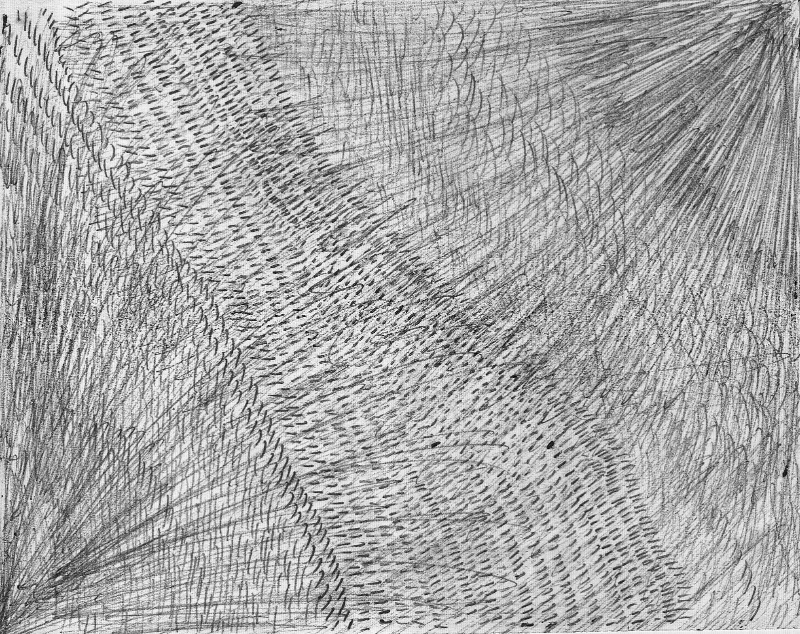
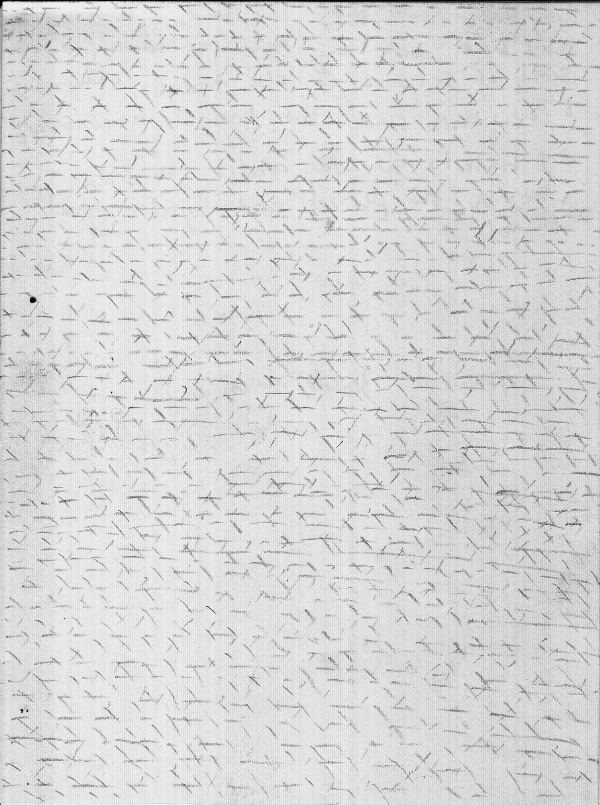
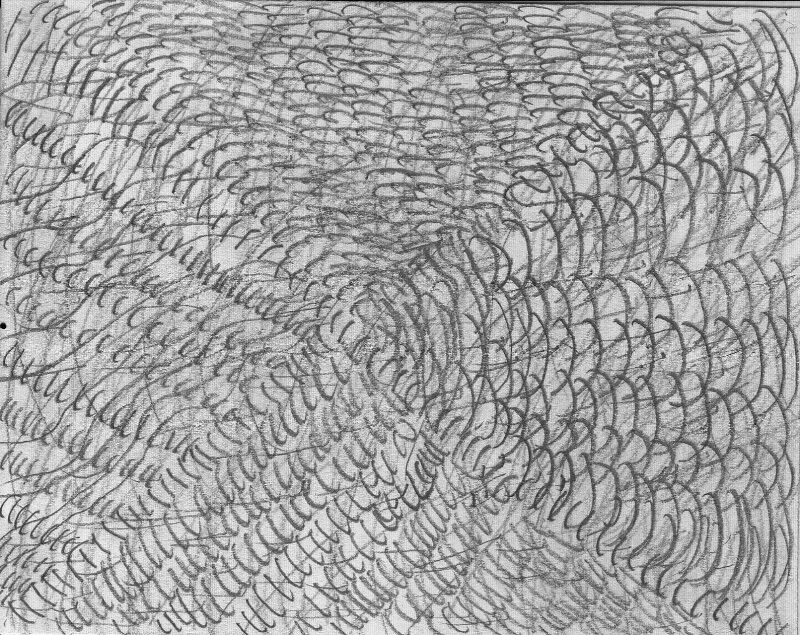
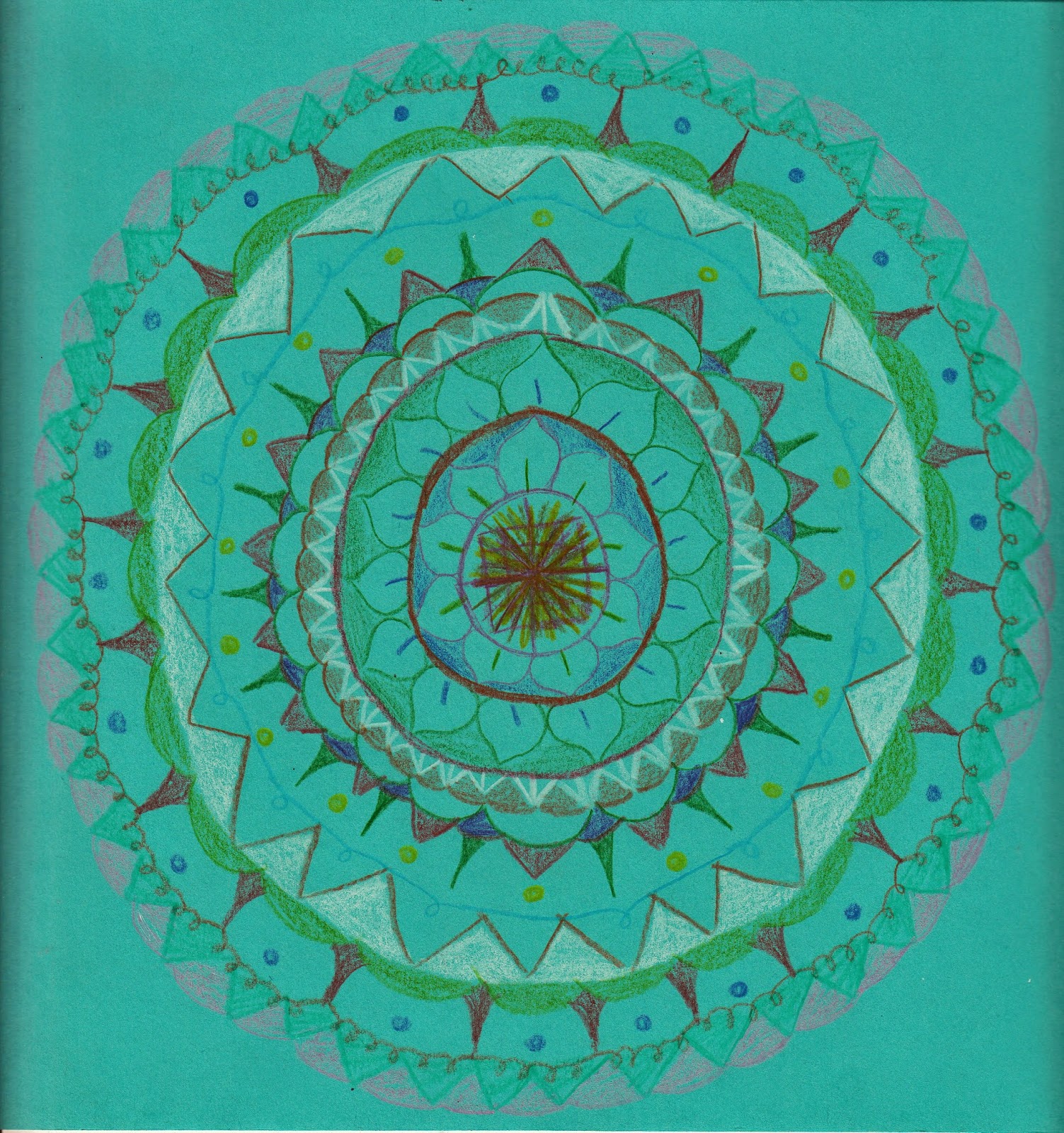
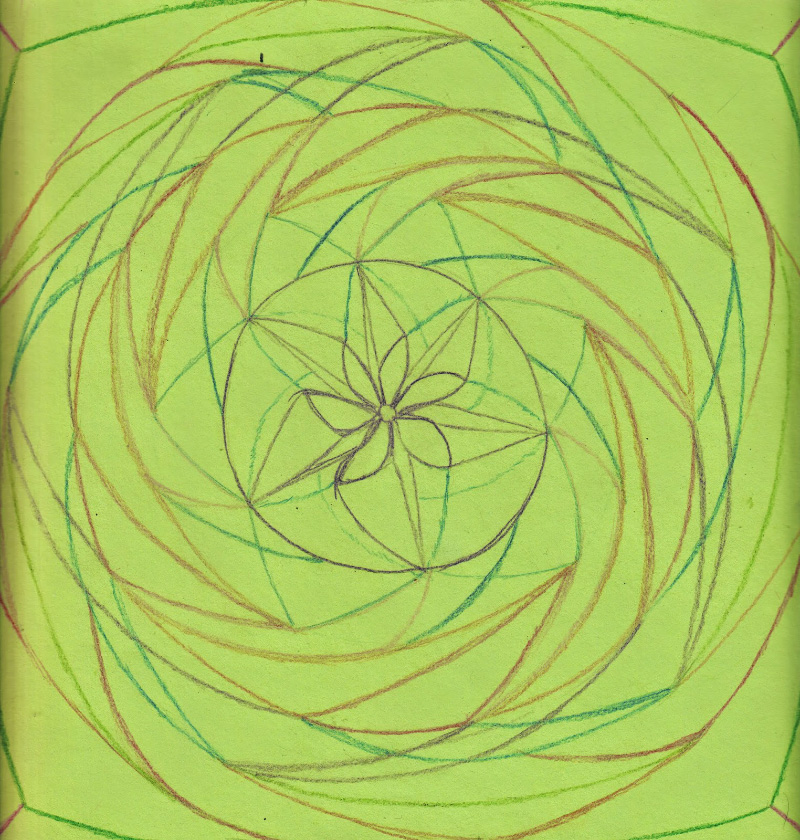
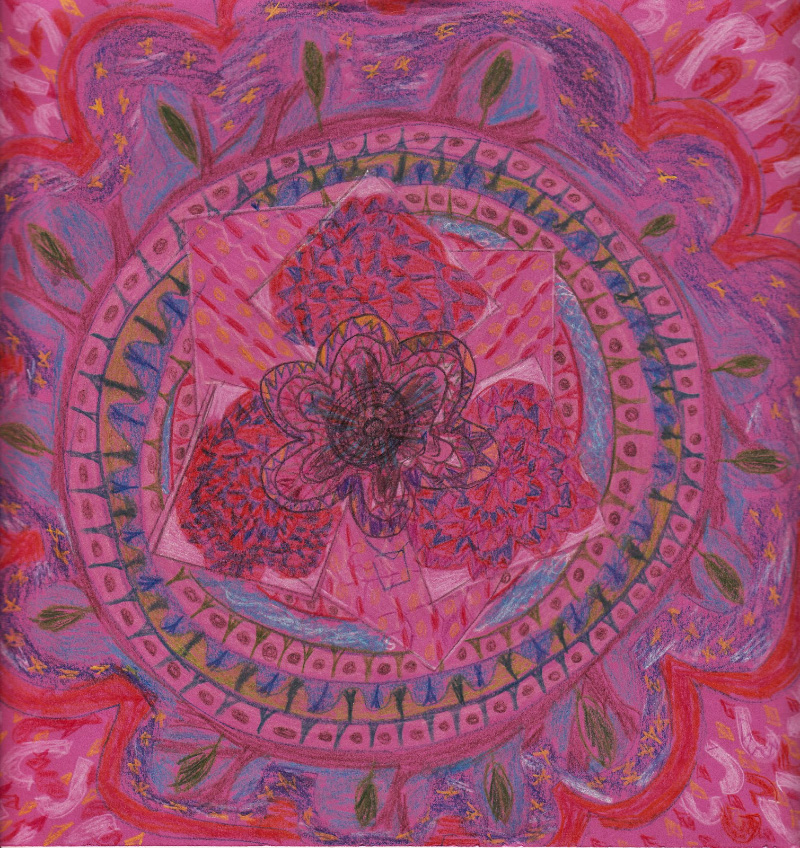
Materials + Supplies
- Music: First I chose Philip Glass’s Satyagraha. Then students were allowed to listen to their own choice on headphones if it induced Flow.
- Pencils
- A variety of wet and dry 2D media
- Watercolor paper, sulphite paper, and colored pastel paper
- Colored pencils
MCA Connections
A contemporary artist, Scott Ramon, inspired some of our work. I am hoping to connect the students to more MCA work that addresses Flow from either past or near future exhibits.
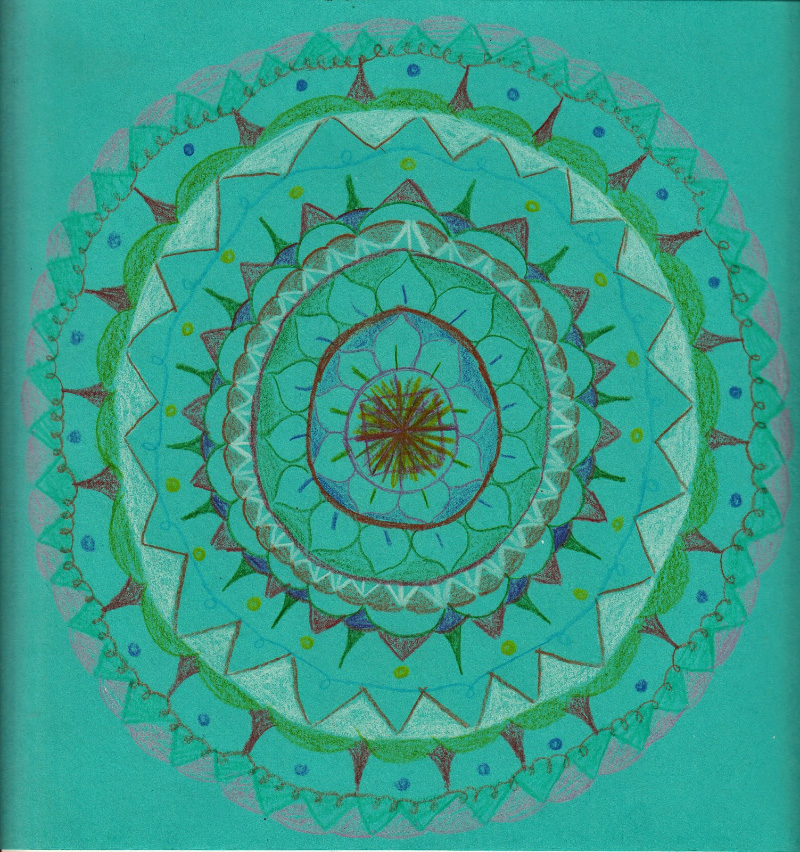
Resources
References:
- Mihaly Csikszentmihalyi “Flow”
- Scott Ramon
- Tibetan Mandalas (Thangkas and Sand)
-Philip Glass: Satyagraha - Valerie's blog, featuring images from this project and many others
- Journaling using Studio Thinking language after each artwork.
- Production Site at the MCA, an exhibit exploring artists' process and workspaces, curated by Dominic Molon
Valerie Xanos
Curie Metro High School
Growing up an artist on the Southwest side of Chicago isn’t easy. There isn’t much exposure to the arts down there. Valerie Xanos became a teacher in the public school system to be an agent of change for young artists. Valerie grew up and still lives where she teaches, sharing a connection to her students through community. A 17-year veteran of CPS, her BFA and teaching certificate were earned at The School of The Art Institute of Chicago and The Glasgow School of Art. As an artist, she works in the media of paint, collage, and photography. Interested in the Guerrilla Art movement, she uses this to influence her curriculum. It is a wonderful genre to affect social change through art in the community. She teaches two Guerrilla Art classes at Curie High School; you can see their art on student blogs: (links:http://guerrillaart4.blogspot.com text:Guerrillaart4 popup:yes) and (links:http://guerrillaart5.blogspot.com caption:Guerillaart5 popup:yes). She is also a mother of four amazing, willful, active young adults. They are often an inspiration to Valerie as a teacher.
Valerie reflects on her creative process:
Going into the Teacher Institute, I wanted to rewrite the curriculum for my Art 1 class. Students were struggling with the Studio Drawing curriculum we had been using. My goal was to give students aspects of artmaking they were missing: exploration, creative/artistic process, autonomy, play, creativity, reflection, and a sense of connection. I believed a contemporary approach would achieve this.
I don’t like the present approach of teaching through the elements and principles. I DO NOT create that way. Using a contemporary approach is more comfortable and compatible with the way I MAKE art. Through experiencing methods I want to employ, through brainstorming and feedback with other teachers & MCA staff, through exposure to MCA exhibits and artists, through the support of the MCA… I have found a way to experiment and explore in a safe way.
This means exploring with the students, being more thoughtful in our approach as explorers, using contemporary approaches, getting students to move out of their comfort zone, getting students to connect with each other and their inner creative selves.
Teaching is an art form. So much thought goes into each step, each move I make, how I teach the students to connect, how I teach the students the artistic process, to think and create in their true voices. I am constantly approaching this not only as a teacher, but as an artist and maker myself! Constantly looking to other contemporary artists and THEIR process for answers.
